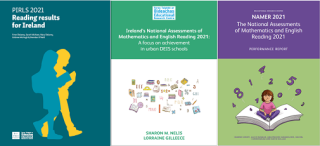Achievement gap remains between DEIS and non-DEIS schools

Attainment gaps between DEIS and non-DEIS schools at primary level remain, despite the positive headline results in the most recent studies conducted by the Educational Research Centre examining mathematics, reading literacy and English reading. Over 10,000 pupils from 188 primary schools participated in the National Assessments in Mathematics and English Reading (NAMER). Over 4,500 pupils from 148 primary schools participated in the Progress in International Reading Literacy Study (PIRLS). The fact that progress has been maintained is very positive, but the lack of progress in further closing the achievement and attainment gaps between DEIS and non-DEIS post primary schools is a cause for concern.
Progress maintained
NAMER assessed English reading at Second class and Mathematics at Sixth class. Findings showed that on average, performance in 2021 was very similar to performance in 2014 – the last time that NAMER was conducted. Over 4,500 pupils from 148 primary schools participated in the Progress in International Reading Literacy Study (PIRLS). PIRLS assessed reading achievement at primary level and also found stability in levels of reading achievement between the previous cycle of PIRLS (conducted in 2016) and the most recent cycle in 2021. Findings of stability from both studies are welcomed in the context of Covid-19-related disruptions to learning and teaching in recent years. Result from PIRLS were particularly positive, however it is important to bear in mind that due to the pandemic, students were on average 6 months older than previous cohorts when tested and therefore probably performed somewhat better than if they had been tested.
Achievement gap remains
A separate report by the Educational Research Centre – Ireland’s National Assessments of Mathematics and English Reading 2021: A focus on achievement in urban DEIS schools – examined the mathematics and English achievement of pupils in urban DEIS schools. Findings show that at both Second and Sixth class, pupils in Urban Band 1 schools had significantly lower levels of achievement than their counterparts in Urban Non-DEIS schools. The achievement gap is considered large (based on measures of effect size). Nonetheless, the achievement gap at Second class between average reading scores in Urban Non-DEIS schools and Urban Band 1 schools reduced a little between 2014 and 2021, although the change was not statistically significant.
About 13 per cent of Second class pupils in Urban Band 1 schools were classified as “very low” achievers in reading, compared to 5% in Urban Non-DEIS schools and 7 per cent in Urban Band 2 schools. Overall, more than two-fifths of Second class pupils in Urban Band 1 schools had reading scores in the “low” or “very low” range. There was little evidence of progress towards the DEIS plan target to reduce the percentage of low achievers in Urban Band 1 schools by 2020. In contrast, the target for high achievers in Urban Band 1 schools appears to have been met as 25 per cent of Second class pupils were classified as “high” reading achievers in line with the target value of 25 per cent.
Focusing on reading achievement in Urban Band 2 schools, Second class pupils achieved an average reading score that was significantly lower than that of pupils in Urban Non-DEIS schools.
Turning to mathematics at Sixth class, there was no statistically significant difference between the average mathematics achievement of pupils in Urban Band 2 schools and pupils in Urban Non-DEIS schools. The gap between average mathematics achievement in Urban Band 1 schools and Urban Non-DEIS schools remains large and almost half of Sixth class pupils in Urban Band 1 schools were “low” or “very low” achievers in mathematics. While there is limited evidence of progress towards either the DEIS plan target for low achievers or the target for high achievers in mathematics in Urban Band 1 schools, it is promising that there was some change in the right direction. For example, although not statistically significant, there was a small increase in the percentage of high achievers in mathematics in Urban Band 1 schools, increasing from about 19 per cent in 2014 to 22 per cent in 2021.
Findings from PIRLS also provide some insights into levels of reading achievement of Fifth class pupils in DEIS schools. Similar to findings from NAMER, pupils in Urban Band 1 schools had a significantly lower average reading score in PIRLS than pupils in non-DEIS schools. Furthermore, pupils in Urban Band 2 schools had a significantly lower reading score than pupils in non-DEIS schools. Authors of the report note that findings from 2021 broadly replicate the pattern seen in PIRLS 2016, with a somewhat wider DEIS/non-DEIS achievement gap in 2021 (although this change was not statistically significant). Focusing on socio-economic status (SES) at the level of the individual pupil (rather than the school), findings from PIRLS show that the average reading achievement of pupils with higher SES was substantially and significantly higher than that of pupils with middle or lower SES. The achievement gap in Ireland was similar to the average gap internationally. Compared to peers with higher SES, pupils with lower SES in Ireland were somewhat less likely to have mastered basic reading skills and much less likely to have mastered more advanced reading skills.
Authors of the three reports highlight the challenges experienced by pupils, families and school communities in recent years arising from the Covid-19 pandemic but note that it is not possible to determine the impact of Covid-19 on findings from these studies. Further evidence of levels of achievement in Irish schools will come from results of the Programme for International Student Assessment (PISA) and from the Trends in International Mathematics and Science Study (TIMSS). Findings of these studies are expected in December 2023 and December 2024, respectively.